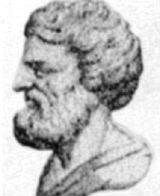

Little is known of the life of Apollonius of Perga. When he was a young man, he went to Alexandria where he studied under the followers of Euclid and later he taught there.
He was known as "The Great Geometer". His works have had a very great influence on the development of mathematics. In particular his famous book Conics introduced terms which are familiar to us today such as parabola, ellipse and hyperbola.
There were 8 books in Conics, but only the first 4 have survived in Greek, and only the first 7 have survived in Arabic. Books 1 to 4 form an elementary introduction to the basic properties of conics. Most of the results in these books were known to Euclid, Aristaeus and others, but some are worked out more fully and generally than in the writings of others.
In book 1 the relations satisfied by the diameters and tangents of conics are studied, while in book 2 Apollonius investigates how hyperbolas are related to
their asymptotes, and he also studies how to draw tangents to given conics. There are, however, new results in these books in particular in book 3.
Books 5 to 7 are highly original. In these Apollonius discusses normals to conics and shows how many can be drawn from a point. He gives
propositions determining the center of curvature which lead immediately to the Cartesian equation of the evolute.
Pappus gives some indications of the contents of six other works by Apollonius. These are Cutting of a ratio, Cutting an area, On determinate section, Tangencies, Plane loci, and On verging constructions. In On the Burning Mirror Apollonius showed that parallel rays of light are not brought to a focus by a spherical mirror, as had been previously thought, and discussed the focal properties of a parabolic mirror. From other sources there are references to still further books by Apollonius, none of which have survived. He is thought to have approximated pi more closely than Archimedes.
To illustrate how far Apollonius had taken geometric constructions beyond that of Euclid's Elements, we consider results which are known to have been
contained in Tangencies. In book 3 of the Elements, Euclid shows how to draw a circle through three given points. He also shows how to draw a tangent to
three given lines. In Tangencies, Apollonius shows how to construct the circle which is tangent to three given circles. More generally he shows how to
construct the circle which is tangent to any three objects, where the objects are points or lines or circles.
Apollonius was also an important founder of Greek mathematical astronomy, which used geometrical models to explain planetary theory. He made substantial contributions, particularly using his great geometric skills. In particular, he made a study of the points where a planet appears stationary, namely the points where the forward motion changes to a
retrograde motion or the converse.
There were also applications made by Apollonius, using his knowledge of conics, to practical problems. He developed the hemicyclium, a sundial which has
the hour lines drawn on the surface of a conic section giving greater accuracy.